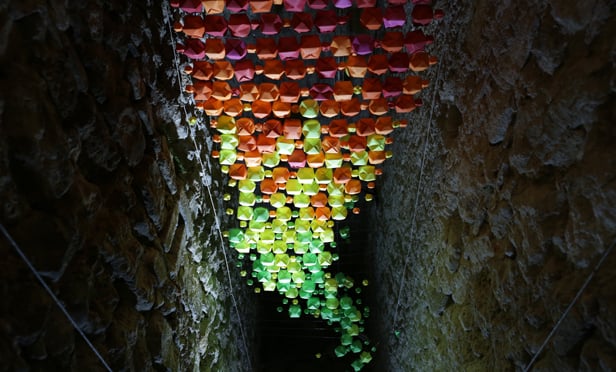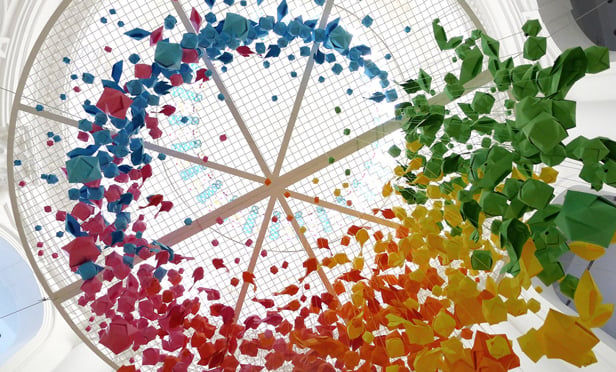 Parc de La Villette in Paris is one of Mademoiselle Maurice’s installations. (Credit: Mademoiselle Maurice)
Parc de La Villette in Paris is one of Mademoiselle Maurice’s installations. (Credit: Mademoiselle Maurice)
GLENDALE, CA—Her delicate paper, lace and embroidery creations, threaded together to form colorful works of art, are displayed on city walls, and suspended from the ceilings of museums and festival venues. French street artist Mademoiselle Maurice’s playful installations aren’t necessarily the type of art you’d see in most Fortune 500 offices, but CBRE is known for being on the leading edge.
“Companies are starting to realize that a beautiful piece of art says as much about a company as does a particular brand message,” said Anne-Laure Lemaitre, head of FatCap, a global agency connecting street and graffiti artists with clients. “Art is a great way to advertise yourself without saying a word.”
In 2013, CBRE—an S&P 500 company headquartered in Los Angeles — embarked on a new course in its workplace strategy, also referred to as Workplace360. New offices opened under this initiative are collaborative, open spaces where the integration of technology—all of them are paperless and address-free environments – and the well-being of employees are the main focus.
“Our company clients usually say art creates a more positive working environment and that people work better when they are surrounded by beauty,” said Lemaitre.
As Lewis C. Horne, president for CBRE’s Greater Los Angeles and Orange County region, searches for new offices for his employees in the area, their well-being and the quality of the spaces they work in has been at the forefront of his mind.
“Everything we do is about attracting and retaining the highest-caliber workforce,” Horne said. “We all spend long hours at work, we all dedicate the majority of our time to our jobs. Providing an environment that is conducive to health and wellness is a big priority here at CBRE, and I think incorporating art into the mix is a huge and important component.”
The Masonic Temple, which also boasts wellness features such as high air-quality standards, an abundance of natural light and ergonomic work stations, is the latest addition to the about 28 offices that have opened worldwide so far. These forward-thinking working environments also aim to integrate art to honor the uniqueness of each building and the city and country they sit in.
“In the past ten years companies have become far bolder and more creative in office décor and their use of art,” said Lemaitre. “Many want the art work to fit the space like a glove, to be a greeting element, have their space act as a frame.”
FatCap helps to find the right artist for a particular client, manages the project, takes care of logistics and tends to client needs such as video-taping the actual installation of a piece.
Over the past two years, CBRE has investigated several artistic concepts for its offices. The company reached out to DG Hunt & Associates, which introduced the firm to avant-garde media artist Refik Anadol. He designs and builds magnificent “data sculptures” by using custom algorithms that translate live data into stunning visuals and site-specific experiences. The company has also been in conversations with an outfit called Turning Art as an opportunity to bring art into CBRE offices on a rotating program.
The Masonic Temple is especially unique in that it is CBRE’s first adaptive reuse project. The nearly 90-year-old building was refurbished by developer Caruso Affiliated Inc. and has had a long and colorful history. This could soon be reflected in the bright tints of Maurice’s creation on one of the Temple’s main walls under the 37 foot ceiling.
As CBRE increasingly embraces the concept of a paperless office environment, the symbolism of using paper as art instead of simply as a substrate for printouts is particularly appealing as CBRE is choosing the right installation for the Masonic Temple.
 Mademoiselle Maurice’s piece at the National Art Museum in Singapore
Mademoiselle Maurice’s piece at the National Art Museum in Singapore
Maurice’s creations have been featured in such varied locations as on outdoor walls in European cities, at Le Carrousel du Louvre in Paris and at the National Art Museum in Singapore. One of her paper installations also adorns a wall at Google’s office in Berlin, Germany.
“The rise of startups buoyed demand for graffiti,” said Lemaitre. “But today, companies that are far more classical and conservative are now looking at this type of art as well. CBRE was really among the first in that category to show an interest in graffiti culture.”
CBRE first started to form the idea of incorporating street art when it was building its Downtown LA headquarters office. The two top floors of the South Hope building had been vacant for decades. CBRE turned them into a functional, modern office. Part of bringing the space back to life was finding an artist who could provide a unique touch to one of its prominent walls. CBRE chose graffiti artist Augustine Kofie who, within two weeks and 20 gallons of acrylic, created a 127-foot long mural featuring geometric forms in greens, oranges and yellows.
“I liked the way you guys approached me,” Kofie said. “I like the energy. And this is serious; this is a new space. It’s for the employees. I like all those factors.”
Following in the West Coast’s footsteps, CBRE’s Chicago office hired artists Chris Silva and Brian Steckel to install a mixed-media piece made almost entirely of reclaimed wood that includes a 12 minute loop of subtle slow-moving light programming. The Tokyo office, shortly after relocating the company’s Japan headquarters to the city’s Marunouchi District, invited street artists Rinpa Eshidan, Esow and Shinichiro Inui to spray paint office walls, draw cartoon art and incorporate traditional motives such as carp. In Honolulu, the firm’s local managing director found an artist out of San Francisco, Aaron De La Cruz, to honor the office operations manager as a tribute to her great work on this project.
“Particularly in real estate, art can really make a difference,” Lemaitre said. “We have seen extensive use of art installations in buildings that are being revamped to help attract renters or buyers. In that way art has become a calling card for a company as well as an actual real estate tool.”
Nary La is creative manager for CBRE’s Greater Los Angeles and Orange County region. The opinions expressed herein are the author’s own.

















 Copyright © 2024 ALM Global, LLC. All Rights Reserved.
Copyright © 2024 ALM Global, LLC. All Rights Reserved.